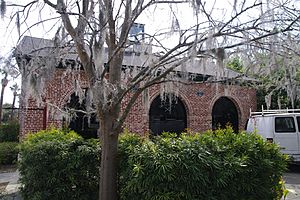Reconstruction Era National Historical Park facts for kids
Quick facts for kids Reconstruction Era National Historical Park |
|
|---|---|

The Old Beaufort Firehouse, site of Reconstruction Era National Historical Park Visitor Center, March 2011
|
|
| Location | Beaufort County, South Carolina |
| Area | 64.99 acres (26.30 ha) |
| Website | Reconstruction Era National Historical Park |
| Designated | January 12, 2017 |
| Lua error in Module:Location_map at line 420: attempt to index field 'wikibase' (a nil value). | |
The Reconstruction Era National Historical Park is a special place in Beaufort County, South Carolina. It was created in January 2017 by President Barack Obama. This park helps us remember and learn about the Reconstruction Era. This important time in American history happened right after the American Civil War.
The park was first called the Reconstruction Era National Monument. It was the first national monument made to honor this period. Later, in March 2019, a law changed its name to a National Historical Park. The National Park Service takes care of the park.
How the Park Was Created
It took many years to create the Reconstruction Era National Historical Park. The idea started about 15 years before it became a park. In the late 1990s, a government official named Bruce Babbitt visited the Beaufort area. He was with a historian named Eric Foner. They thought this area would be a good place for a national monument.
At first, the idea faced some challenges. Some groups did not want the monument to be created. In 2004, a plan for a "Beaufort Reconstruction History Park" was considered. But some groups spoke against it.
The idea came back in 2015. Two historians, Gregory Downs and Kate Masur, studied places linked to the Reconstruction era. They wrote a report about important historical sites. In 2016, a meeting was held in Columbia, South Carolina. People talked about the Reconstruction Era and the idea of the park. At this meeting, it seemed that some of the earlier opposition had lessened.
Two U.S. Representatives from South Carolina, Jim Clyburn and Mark Sanford, strongly supported the park. They worked to make it happen through a law. In December 2016, a public meeting was held. Many people supported creating the monument using the President's special powers. A descendant of Robert Smalls also supported the park. Robert Smalls was a formerly enslaved person who became a member of Congress during Reconstruction.
President Obama created the monument in his final days in office. He used a law called the Antiquities Act. This law lets the president create national monuments. On the same day, he also created two other national monuments. These honored the American civil rights movement.
A special ceremony was held in March 2017 to celebrate the new park. The dedication was also part of the annual Original Gullah Festival.
Places to Visit in the Park
The park includes four important locations in and around Beaufort, South Carolina. The Union Army took control of the Beaufort area in November 1861. This made it one of the first places where formerly enslaved people could vote, buy land, and start churches, schools, and businesses.
Here are the four sites that are part of the park:
- Darrah Hall at Penn Center: This was one of the first schools in the South for freed slaves. It started in 1862. In 1864, it moved to its current spot on Saint Helena Island. Penn Center is important for its role in Reconstruction and civil rights. It also helps preserve Gullah culture.
- Brick Baptist Church: This church is next to Penn Center. It was built in 1855 by enslaved people. In 1861, after the Battle of Port Royal, about 8,000 freed slaves took over the church. It is the oldest church on Saint Helena Island.
- The Old Beaufort Firehouse: This building is in downtown Beaufort. It is close to other important historical sites. The old firehouse is now the visitor center for the national historic park. It is also part of the larger Beaufort National Historic District.
- Camp Saxton Site/Emancipation Grove: This site is in Port Royal. On New Year's Day 1863, Union Army General Rufus Saxton read the Emancipation Proclamation here. About 3,000 enslaved people from the nearby Sea Islands heard him. This was also where some of the first African Americans joined the U.S. Army. They became soldiers in the 1st South Carolina Volunteers. The Emancipation Oak, a large oak tree, is in a nearby grove. This area is now part of Naval Hospital Beaufort.

